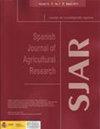不同主动式耕作机械耕作作用对工作深度以下土壤压实的影响分析
IF 0.8
4区 农林科学
Q3 AGRICULTURE, MULTIDISCIPLINARY
引用次数: 0
摘要
研究目的:对砂壤土中不同活性耕作机械的耕作作用在耕作深度以下引起的土壤压实数据进行量化。 研究领域:印度哈里亚纳邦希萨尔CCS哈里亚纳农业大学研究农场 材料和方法:用锥指数(CI)、体积密度和孔隙率对数据进行量化。它还与农民遵循的传统做法进行了比较,仅涉及被动耕作工具(即耕耘机和圆盘耙)。该结果不代表拖拉机在轮胎下施加的土壤压实。 主要结果:工作深度下土壤压实增量最大的是旋耕机,其次是常规做法、pto操作盘式分蘖机和动力耙,分别为6.67 ~ 7.05%、5.17 ~ 5.29%、4.29 ~ 4.97%和2.08 ~ 2.36%。容重增量与前文相似,分别为3.96 ~ 4.06%、2.30 ~ 2.42%、1.71 ~ 1.88%和1.31 ~ 1.40%。土壤孔隙度降低幅度最大的是旋耕机,其次是常规耕作、pto操作盘式分蘖和动力耙,分别为5.67 ~ 6.61%、2.74 ~ 2.94%、1.71 ~ 1.88%和2.06 ~ 2.25%。 研究重点:主动式旋转式耕作机械在耕作过程中对土壤施加压缩力,造成土壤压实。它们创造最佳的表土耕度,但由于叶片速度,可以压实更深的土壤,需要选择理想的旋转和前进速度,以尽量减少这种压实。本文章由计算机程序翻译,如有差异,请以英文原文为准。
Analysis of soil compaction induced beneath the working depth due to tilling action of different active tillage machinery
Aim of study: To quantify the data regarding soil compaction induced beneath the tillage working depth purely due to the tilling action of the different active tillage machinery in sandy loam soil.
Area of study: Research Farm, CCS Haryana Agricultural University, Hisar, Haryana, India
Material and methods: The data were quantified in terms of cone index (CI), bulk density, and porosity. Its comparison was also made with conventional practice followed by the farmers, involving only passive-tillage tools (i.e. cultivator and disc harrow). The results did not represent the tractor-imposed soil compaction under the tires.
Main results: The maximum soil compaction beneath the working depth in terms of increment in soil CI occurred with rotavator followed by conventional practice, PTO-operated disc tiller, and power harrow, which are in the range of 6.67-7.05%, 5.17-5.29%, 4.29-4.97%, and 2.08-2.36%, respectively. The increment in bulk density was similar to that as mentioned above with values in the range of 3.96-4.06%, 2.30-2.42%, 1.71-1.88%, and 1.31-1.40%, respectively. Furthermore, the maximum decrement in soil porosity occurred with rotavator followed by conventional practice, PTO-operated disc tiller, and power harrow which were in the range of 5.67-6.61%, 2.74-2.94%, 1.71-1.88%, and 2.06-2.25%, respectively.
Research highlights: The active tillage rotary machinery cause soil compaction due to the applied compressive force on the soil during their tilling action. They create optimal topsoil tilth but can compact deeper soil due to blade speed, necessitating the selection of ideal rotational and forward speeds to minimize this compaction.
求助全文
通过发布文献求助,成功后即可免费获取论文全文。
去求助
来源期刊

Spanish Journal of Agricultural Research
农林科学-农业综合
CiteScore
2.00
自引率
0.00%
发文量
60
审稿时长
6 months
期刊介绍:
The Spanish Journal of Agricultural Research (SJAR) is a quarterly international journal that accepts research articles, reviews and short communications of content related to agriculture. Research articles and short communications must report original work not previously published in any language and not under consideration for publication elsewhere.
The main aim of SJAR is to publish papers that report research findings on the following topics: agricultural economics; agricultural engineering; agricultural environment and ecology; animal breeding, genetics and reproduction; animal health and welfare; animal production; plant breeding, genetics and genetic resources; plant physiology; plant production (field and horticultural crops); plant protection; soil science; and water management.
 求助内容:
求助内容: 应助结果提醒方式:
应助结果提醒方式:


